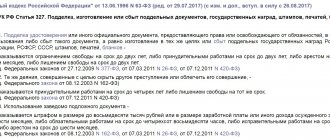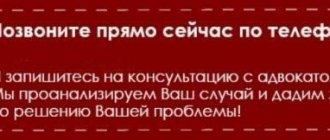What is a forgery of an employment contract?
As a rule, an employment contract is forged either by the employee or his employer. The main goal is to use such a document in accordance with its purpose. Specific motives for counterfeiting may be different, in particular:
- confirmation of the existence of an employment relationship;
- creating evidence of an employment relationship that did not actually exist;
- changing the terms of the employment contract to a more advantageous direction for oneself and (or) to a disadvantage for the other party;
- error correction.
An employment contract as the subject of an offense (crime) is a document (the medium and its contents) that is forged.
The fake may include the following:
- production (drawing up) in whole or in part of a fictitious document;
- erasure;
- addition;
- correction of information;
- signature forgery;
- certification with a fake seal.
Thus, the entire document, its individual details, text, words, signature, etc. turn into ones that do not correspond to reality (false, fictitious). An employment contract may be fictitious insofar as it should not have been drawn up in principle (there was no employment relationship). Or it may be fake due to changes in its content. The method of forgery does not play a special role. The very fact of drawing up a completely or partially fictitious employment contract is important.
Forgery of documents
A document is a material medium that contains information of any form (text, sound, image). A document always has special features that allow it to be distinguished from similar materials. The purpose of the document is for public use.
Responsibility for the intentional unlawful use of false documents is provided for by the same articles of the Criminal Code of the Russian Federation as the production of such documents. But this is only a minimum, since the fraudster’s guilt will be aggravated depending on the specific case of using the counterfeit.
So, for example, if a fraudster uses a fake travel card and rides public transport for free, he faces a fine of up to 80 thousand rubles. (or in the amount of his six-month income). Or if, for example, a fraudster used a fake higher education diploma when applying for a job, he may be punished with compulsory work for up to 480 hours, correctional labor for up to 2 years, and even six months of arrest. Receiving funds from a bank using a forged document is qualified under at least two articles of the Criminal Code of the Russian Federation - forgery and fraud in the field of lending.
A lawyer will help you understand the elements of a specific crime and will tell you the scope of the fraudster’s liability.
Do you have any questions?
To get the most detailed advice on your issue, you just need to follow any of the suggested options:
- Request a consultation using the form
on our website - Or just call the number: 8 800 350-83-74
Responsibility for falsifying an employment contract
As a rule, we are talking about two options (types) of responsibility:
- Administrative – provided for in Article 19.23 of the Code of Administrative Offenses of the Russian Federation.
- Criminal - provided for in Art. 327 of the Criminal Code of the Russian Federation.
An administrative offense is the forgery of a document confirming the existence of a certain person’s rights or his release from duties. In this case, any document is meant, and the purpose of the forgery does not matter.
Criminal liability is the forgery of an official document granting rights or releasing one from obligations, and specifically for the purpose of using such a document.
Will the employment document be official in the context of possible criminal liability for its falsification? Or is only administrative liability possible here?
According to judicial practice, in particular, the position of the Constitutional Court of the Russian Federation (Determination of May 19, 2009 No. 534-O-O, Determination of December 16, 2010 No. 1671-O-O):
- The concept of “official document” in specific conditions is evaluative in nature.
- Law enforcers in each specific case have the right to evaluate the properties of the document - official or unofficial, granting rights, releasing from obligations or not doing so - depending on the situation and circumstances of the case.
There is no exhaustive list of official and other documents in the legislation. And nowhere at the legislative level is it stated what type of employment contract belongs. Therefore, in practice it can be extremely difficult to give a correct assessment - it is imperative to look at the circumstances of the case, the reasons, motives, purposes of forging an employment contract, its use or non-use, the consequences of an offense or crime.
In any case, criminal liability of the employee or employer arises only if the purpose of the forgery was the use of a fictitious employment contract. In other cases, it is an exclusively administrative article, for which the purpose of forgery is not required.
Thus, it does not really matter whether the employer forged the employee’s signature in the employment contract or the employee drew up a fictitious contract - law enforcement agencies will look at all the circumstances of the case in their entirety.
If you are charged under Part 1 of Art. 327 of the Criminal Code of the Russian Federation, possible types of punishment:
- restriction of freedom, forced labor or imprisonment for up to 2 years;
- arrest up to 6 months.
If administrative liability is threatened under Article 19.23 of the Code of Administrative Offenses of the Russian Federation, the punishment depends on the status of the offender. What the employer faces is a 30-50 ruble fine for the first time and 50-100 thousand rubles for a repeated violation. But if an employee forged an employment contract, then administrative liability is excluded. It is provided only for legal entities.
Situations when a fictitious employment contract is used as evidence in court should be viewed somewhat differently. Here we are talking about criminal liability under Part 1 of Art. 303 of the Criminal Code of the Russian Federation – falsification of evidence in a civil or administrative case by a participant in the proceedings or his representative. And the recognition of an employment contract as an official document in such cases no longer matters. It is important that it was falsified for presentation to the court and presented. Judicial practice often deals with such situations, since employment contracts are legally significant documents and evidence in labor disputes between employers and employees.
Responsibility under Part 1 of Art. 303 of the Criminal Code of the Russian Federation:
- a fine of 100-300 thousand rubles or in the amount of income for 1-2 years;
- compulsory work up to 480 hours;
- repair work up to 2 years;
- or arrest for up to 4 months.
Only individuals are held criminally liable. This could be an employee. Or it could be an employee of the employer who directly drew up the fictitious document. For example, a forged signature of a director on an employment contract is often an initiative of personnel officers.
Forged signature: The Supreme Court decided the fate of the treaty
In July 2015, Bashkhiminvest took out a loan from Uralkapitalbank. The loan amount was 135 million rubles, the interest rate was 25%, and the repayment period was one year. The return of the money was secured by a mortgage on the administrative building and the land under it - the mortgage agreement was concluded on the same day. The property was located in Ufa and belonged to four shared owners: Evgenia Sergeeva (3/10), Oksana Gerasimova (3/10), Denis (1/10) and Diana Kirillov (3/10).* The total value of the property, by agreement of the parties, exceeded 355, 7 million rub. Later, the Kirillovs, with their consent, sold their pledged shares to Yuri Fedorov*.
In June 2018, Uralkapitalbank was declared bankrupt (case No. A07-6555/2018). By that time, Bashkhiminvest had not repaid the loan; as of May 2021, its debt to the bank amounted to 144.4 million rubles. taking into account accrued interest.
The credit institution, represented by its bankruptcy trustee, the Deposit Insurance Agency, decided to return the money through the courts. The bank asked the court to collect the debt from Bashkhiminvest, as well as to foreclose on the mortgaged property. Sergeeva filed a counterclaim against the credit institution, demanding that the pledge agreement be recognized as unconcluded. The owner insisted that her signature on the document was forged.
Three instances - five decisions
- The Sovetsky District Court of Ufa ordered the company to pay the debt, but did not foreclose on the property, satisfying Sergeeva’s claim and recognizing the pledge agreement as unconcluded (No. 2-5320/2018);
- The Supreme Court of Bashkortostan, on appeal, upheld the recovery of money from Bashkhiminvest, overturned the first instance decision regarding the satisfaction of the counterclaim, rejected Sergeeva’s claims and foreclosed on the property (No. 33-4138/2019);
- The Presidium of the Supreme Court of Bashkortostan, by way of cassation, overturned the decision of the appeal, sending the case for review (No. 44g - 268/2019);
- The appeal proceeded to consideration according to the rules of first instance. The court canceled the act of the lower court, collected the debt from Bashkhiminvest, refused to sell the collateral at auction and declared the mortgage agreement not concluded (No. 33-17848/2019);
- The sixth cassation court overturned the conclusion of the appeal regarding the recognition of the pledge agreement as not concluded in relation to Gerasimova and the Kirillovs, as well as the refusal to foreclose on the corresponding shares. In this part, the court sent the case for review. The remaining findings of the lower court were confirmed by the cassation (No. 88-4451/2020).
Recognizing the mortgage agreement as not concluded, the appeal took into account the results of the handwriting examination. Experts came to the conclusion that Sergeeva’s signature in the contract was forged. Moreover, the owner herself was abroad at the time of concluding the contract, the court found. Thus, the essential terms of the contract with the woman were not agreed upon, therefore, the contract is not concluded, the appeal decided.
The sixth cassation court generally agreed with this conclusion, correcting the appeal only regarding the parties for whom the contract was not concluded. The court recalled that only Sergeeva filed a corresponding claim; the other participants did not make such demands. At the same time, the Supreme Court of Bashkortostan did not explain in any way why it recognized the agreement as not concluded in relation to all pledgors, the cassation noted and sent the case for review in this part.
Uralkapitalbank was not happy with this outcome. The credit organization filed a complaint with the Supreme Court, demanding that the acts of lower authorities be canceled regarding the recognition of the agreement as not concluded in relation to Sergeeva and the refusal to foreclose on her share.
What about integrity?
The three judges, chaired by Sergei Astashov, referred to the principle of estoppel (clause 2 of article 10 of the Civil Code). It implies that a person who by his actions has confirmed the validity or conclusion of a contract cannot insist to the contrary.
At the same time, back in October 2014, Sergeeva received her husband’s notarized consent to pledge property acquired during marriage. And on September 22, 2015, the woman issued a power of attorney to Larisa Novikova* to register the relevant transactions on her behalf. On the same day, Novikova, being an authorized representative of the owner, filed an application to register the mortgage on the basis of the disputed agreement.
The lower courts did not take into account all these circumstances, the Supreme Court noted. The Civil Collegium canceled the acts of appeal and cassation regarding the recognition of the contract as not concluded in relation to Sergeeva, as well as regarding the refusal to foreclose on her share. The judge sent the dispute for review to the Supreme Court of Bashkortostan.
“Moved away from formalism”: experts on the definition
In the definition under consideration, the Supreme Court moved away from the formal approach to the perception of examination as fundamental evidence, the decision of the civil panel is welcomed by Vladislav Aristov from the law firm Lemchik, Krupsky and Partners Lemchik, Krupsky and Partners Federal Rating. group Tax consulting and disputes (Tax disputes) group Arbitration proceedings (medium and small disputes - mid market) group Foreign trade/Customs law and currency regulation group Tax consulting and disputes (Tax consulting) group Family and inheritance law group Digital economy group Bankruptcy (including disputes) (high market) group Intellectual Property (Consulting) group Corporate Law/Mergers and Acquisitions (mid market) group Labor and Migration Law (including disputes) 6th place By number of lawyers 17th place By revenue 22nd place By revenue per lawyer (more than 30 lawyers) Profile companies The court, as the expert notes, pointed out the need to analyze the evidence in its entirety: the fact that the mortgagor, through his active actions, confirmed the reality of the disputed transaction, negates the discovered defects of the contract.
What to do if your signature is forged: decision of the Supreme Court
Victoria Bolshagina from KA Yukov and Partners Yukov and Partners Federal Rating agrees with him. group Dispute resolution in courts of general jurisdiction group Arbitration proceedings (major disputes - high market) group Bankruptcy (including disputes) (high market) group Criminal law 4th place By number of lawyers 12th place By revenue 17th place By revenue per lawyer (more than 30 lawyers) Company profile. According to her, by applying for state registration and submitting the mortgage agreement to the authorized body, Sergeeva, through her representative, expressed her will to conclude the transaction.
The Supreme Court has pointed out the need to establish the existence of such a will before, says Aristov (No. 9-KG20-12-K1). However, practice also knows the opposite examples. Thus, in case No. A55-4260/2017, the courts declared the surety agreement invalid solely on the basis of an examination that established a forgery of the “guarantor’s” signature. At the same time, the Supreme Court confirmed this conclusion without indicating the need to provide other evidence.
According to Aristov, the position of the civil panel in the Sergeeva case can have a positive impact in practice, pushing the courts to a qualitative assessment of the parties’ behavior.
*The names and surnames of the participants in the process have been changed by the editors.
- Kira Klimacheva
- Supreme Court of the Russian Federation
Evidence of signature forgery
In order for a person to be held liable for forging a signature, the offense must be proven. The main evidence of the offense will be a fake document with a false signature and examination results that confirm this violation.
When a suspicion arises that a document has a forged signature, this paper is subjected to an assessment examination. To perform this action, qualified specialists who have the necessary experience and authority are required. Various means are used for verification. In some cases, a fake can be distinguished with the naked eye. In other cases, special tools and equipment are required. During the examination, the method of forging the signature is established. As mentioned above, there are two types: technical and manual. When someone forges a signature by hand, it may differ in the degree of pen pressure or the way the elements are drawn. If a signature is applied using technical means, it is much more difficult to distinguish it from the original.
In preparation for falsifying a signature, the author of the craft sometimes practices writing with a pencil, tracing the original signature. The presence of double lines can reveal a fake. Fraudsters also often use carbon paper, which leaves traces on the original document. If the signature is very similar, but a fake is suspected, it can be printed by a printer. A fake is easy to distinguish: it will be smooth on paper. When an original signature is placed, there is always a factor of pressing on the paper. The pen leaves a small mark.
Significant documents can be forged with the original signature transferred to the forgery. To do this, use photo paper or egg whites. In this case, you can notice the fake by uneven color or by the remains of the auxiliary material.
Falsification of employment records
When checking the document, some entries may seem unreliable. The evidence is:
- An entry that does not comply with the established form, Instructions and Rules.
- The presence of blots that are not allowed by the Labor Code of the Russian Federation.
- The organization's seal is missing or does not meet regulatory requirements.
The record was forged by the employee himself
Having suspected the unreliability of the employment record, the employer has the right to submit an application to law enforcement agencies. Quite often, applicants independently attribute more experience to themselves in an effort to get a prestigious job. If this becomes clear after employment, the employee’s guilt will be proven and he will be fired under Art. 81 Labor Code of the Russian Federation. He will also be held accountable for committing forgery.
Important! Dismissal without investigating the circumstances of the forgery is illegal. The injured employee will be able to challenge the employer’s actions in court and be reinstated in his position.
How to spot a fake
A work book is a state-issued document with certain parameters. Therefore, you can identify a fake by:
- Inconsistency of the number with the state standard or its absence on the document.
- Incorrect number of pages.
- The name of the printing house (work books are printed only at Goznak).
- Identification of a discrepancy in one of the records.
Series and number
This is the most reliable way to verify the authenticity of a document. The series of each work book strictly corresponds to the standard and year of issue.
Characteristics of license plates of old-style books (1977):
- A single number is indicated every 4 pages: on 1, 5, 9 and so on up to 37 pages. There are 10 numbers in total.
- The numbers on all pages must be identical.
- The color of the numbers is red.
The characteristics of license plates for the new model books (2003) are slightly different:
- A single number and series are indicated on pages 1, 3, 9, 15, 19, 23, 27, 31, 33, 37, 39. There are 11 numbers in total.
- All series and numbers must be absolutely identical.
- The color of the series is black, and the color of the numbers is red.
Important! Identifiers are assigned to documents by year of publication. This means that books of the same type were printed at different times. You can compare several documents with each other: license plates should differ in accordance with chronology.
Form
The following form of work book has been approved in Russia:
- The hard cover is made of paper vinyl, the new books are made of fabric vinyl, calico. Older samples may have a cardboard cover.
- A cover page containing the basic information of the employee is required.
- The page type is tabular with lines to indicate information about the work.
- The cover contains the name of the document and the coat of arms of the USSR or Russia (depending on the sample).
Water marks
The pages are numbered, so it is easy to identify whether they are all present in the document. There must also be watermarks to protect against counterfeiting. In old books, irregular lines should be visible on the final pages. In the new ones, the protection is more intricate: a two-color sign can be seen in the light, and the sheets have a kind of mesh.
Printing house
At the end of the book on the bottom line is the name of the printing house that printed it. On old-style documents it says “Goznak 1974”, on modern ones – “MPF Goznak 2003”.
What to do if falsification is detected
Of course, preventing illegal cases related to labor relations gives positive results. However, cases of falsification still occur. That is why it is important to remain vigilant and promptly notify the necessary authorities about the problem.
You can contact the Labor Protection Inspectorate, the prosecutor's office or the judicial authority. However, if it is necessary to verify documents or the company itself, you should not go straight to court. There should be evidence, as well as witness statements, so that the illegality of the actions can be confirmed. Then it will be possible to hold violators accountable and achieve punishment for falsification.
If a person discovers some inconsistencies in the employment contract, then you can first discuss this point with your superiors. Perhaps it will be possible to resolve everything peacefully, and then the case will not go to court. But if you personally were unable to solve the problem, then all that remains is to contact the above authorities.








